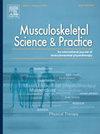物理治疗门诊初步评估后患者缺席及退诊的原因:一项定性研究
IF 2.2
3区 医学
Q1 REHABILITATION
引用次数: 0
摘要
背景患者在初次理疗评估后不参加治疗或中途放弃治疗,会对诊所和治疗师造成很大影响。据我们所知,以前的研究还没有从患者的角度研究过他们为什么只参加了初次评估就终止了推荐的治疗计划。 Objective To gain insights about why patients do not follow through on a recommended physical therapy plan of care after the initial evaluation.方法这项定性研究采用半结构化电话访谈的方式,在一个大型地区医疗保健系统中对接受过肌肉骨骼状况理疗评估的患者进行访谈。如果参与者参加了初次评估,但在 30 天内没有参加随访,并且没有安排未来的预约,则会被有目的地抽样。在数据收集和转录后,进行了编码和主题分析,以确定主要和次要主题。结果共进行了 26 次访谈,包括 12 名男性和 14 名女性,平均年龄为 51.04 (± 15.72)岁。结果共进行了 26 次访谈,包括 12 名男性和 14 名女性,平均年龄为 51.04 岁(± 15.72 岁)。访谈中出现了五个共同主题,包括临床改善率在可接受范围内(23.1%)、就医问题(26.9%)、看不到治疗价值或无法自行治疗(23.1%)、需要其他医疗管理(15.4%)和患者与医疗服务提供者的关系问题(11.5%)。这些结果可能有助于诊所经理和临床医生积极解决障碍、诊所准入问题和评估策略,以最大限度地提高患者对护理计划的跟进。本文章由计算机程序翻译,如有差异,请以英文原文为准。
Reasons for patient no-shows and drop-offs after initial evaluation in physical therapy outpatient care: a qualitative study
Background
No-shows and drop-offs by patients after their initial physical therapy evaluation can significantly impact clinics and therapists. To our knowledge, no previous studies have examined the patient's perspective of why they terminated their recommended plan of care after only attending their initial evaluation.
Objective
To gain insights regarding why patients do not follow through on a recommended physical therapy plan of care after the initial evaluation.
Methods
This qualitative study used semi-structured phone interviews with patients who received a physical therapy evaluation for a musculoskeletal condition within a large regional healthcare system. Participants were purposefully sampled if they attended their initial evaluation, did not attend a follow-up visit within 30 days, and had no future appointments scheduled. After data collection and transcription, coding and thematic analysis took place to establish primary and secondary themes.
Results
A total of 26 interviews were conducted, including 12 males and 14 females, with an average age of 51.04 (± 15.72) years. Five common themes emerged, including clinical improvement at an acceptable rate (23.1 %), access issues (26.9 %), did not see value or could do therapy on their own (23.1 %), other medical management was needed (15.4 %), and patient-provider relationship issues (11.5 %).
Conclusion
These findings highlight the patient's rationale for not following through on a physical therapist's recommended plan of care after an initial evaluation. They may help practice managers and clinicians to proactively address barriers, clinic access issues, and evaluation strategies to maximize the patient's follow-through on their plan of care.
求助全文
通过发布文献求助,成功后即可免费获取论文全文。
去求助
来源期刊

Musculoskeletal Science and Practice
Health Professions-Physical Therapy, Sports Therapy and Rehabilitation
CiteScore
4.10
自引率
8.70%
发文量
152
审稿时长
48 days
期刊介绍:
Musculoskeletal Science & Practice, international journal of musculoskeletal physiotherapy, is a peer-reviewed international journal (previously Manual Therapy), publishing high quality original research, review and Masterclass articles that contribute to improving the clinical understanding of appropriate care processes for musculoskeletal disorders. The journal publishes articles that influence or add to the body of evidence on diagnostic and therapeutic processes, patient centered care, guidelines for musculoskeletal therapeutics and theoretical models that support developments in assessment, diagnosis, clinical reasoning and interventions.
 求助内容:
求助内容: 应助结果提醒方式:
应助结果提醒方式:


